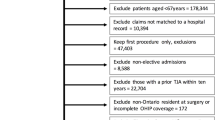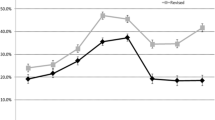Abstract
Purpose
Hip arthroscopy utilization continues to increase worldwide. Post-operative pain management is essential to allow appropriate rehabilitation. While multimodal analgesic protocols have been described, consensus agreement is lacking and opioid analgesia remains a mainstay of treatment. Unfortunately, the risk of persistent opioid use among opioid-naïve and non-naïve patients following hip arthroscopy remains unclear. Therefore, the purpose of this study was to identify rates of persistent post-operative opioid use, as well as to identify factors associated with persistent use.
Methods
A retrospective cohort study was conducted using linked administrative data from Ontario, Canada. Participants were adults who underwent hip arthroscopy between 2013 and 2018. Patients < 18 or > 60 years of age as well as those who had undergone prior hip arthroscopy were excluded. The primary exposure was whether patients had filled ≥ 2 opioid prescriptions within 1 year prior to their hip arthroscopy to define the opioid naïve and non-naïve populations. The primary outcome was persistent opioid use, defined as 2 + prescriptions filled between 9 and 15 months post-op. A regression analysis was performed to identify factors associated with persistent opioid usage.
Results
Of the 1909 patients, 1525 (79.9%) were opioid-naïve, while 384 (20.1%) had a prior history of opioid use within 1 year of surgery. 224 patients (11.7%) demonstrated persistent opioid use, with ≥ 2 prescriptions filled between 9 and 15 months post-op. Of those, 42 (18.8%) cases were among opioid-naïve patients, while the remaining 182 (81.2%) were among non-naïve patients. The risk of persistent post-operative use was significantly higher in those with prior opioid use (OR 31.95, 95% CI 22.15–46.09; p < 0.0001). Regression analysis confirmed that pre-operative opioid use (OR 23.79, 95% CI 17.06–33.17; p < 0.0001) and older age (OR 1.04, 95% CI 1.02–1.05, p < 0.0001) were associated with increased risk of persistent post-operative opioid use.
Conclusion
Following hip arthroscopy, persistent opioid use is common. New persistent use was identified in 2.7% of opioid-naïve patients, compared with continued use in 47.4% of non-naïve patients. Pre-operative opioid use and older age were associated with the greater risk of persistent post-operative opioid use.
Level of evidence
Level III.
Similar content being viewed by others

References
Almasri M, Simunovic N, Heels-Ansdell D, Ayeni OR (2021) Femoroacetabular impingement surgery leads to early pain relief but minimal functional gains past 6 months: experience from the FIRST trial. Knee Surg Sport Traumatol Arthrosc. https://doi.org/10.1007/s00167-020-06401-x
Anciano Granadillo V, Cancienne JM, Gwathmey FW, Werner BC (2018) Perioperative opioid analgesics and hip arthroscopy: trends, risk factors for prolonged use, and complications. Arthroscopy 34:2359–2367
Austin PC (2009) Using the standardized difference to compare the prevalence of a binary variable between two groups in observational research. Commun Stat Simul Comput 38:1228–1234
Beck EC, Nwachukwu BU, Jan K, Krivicich LM, Chahla J, Fu MC, Nho SJ (2020) The effect of postoperative opioid prescription refills on achieving meaningful clinical outcomes after hip arthroscopy for femoroacetabular impingement syndrome. Arthroscopy 36:1599–1607
Benchimol EI, Smeeth L, Guttmann A, Harron K, Moher D, Petersen I, Sørensen HT, von Elm E, Langan SM, Working Committee RECORD (2015) The REporting of studies Conducted using Observational Routinely-collected health Data (RECORD) statement. PLoS Med 12:e1001885
Dold AP, Murnaghan L, Xing J, Abdallah FW, Brull R, Whelan DB (2014) Preoperative femoral nerve block in hip arthroscopic surgery: a retrospective review of 108 consecutive cases. Am J Sports Med 42:144–149
Dwyer CL, Soong M, Hunter A, Dashe J, Tolo E, Kasparyan NG (2018) Prospective evaluation of an opioid reduction protocol in hand surgery. J Hand Surg Am 43:516-522.e1
Garner M, Alsheemeri Z, Sardesai A, Khanduja V (2017) A prospective randomized controlled trial comparing the efficacy of fascia iliaca compartment block versus local anesthetic infiltration after hip arthroscopic surgery. Arthroscopy 33:125–132
Gil JA, Gunaseelan V, DeFroda SF, Brummett CM, Bedi A, Waljee JF (2019) Risk of prolonged opioid use among opioid-naïve patients after common shoulder arthroscopy procedures. Am J Sports Med 47:1043–1050
Hah J, Mackey SC, Schmidt P, McCue R, Humphreys K, Trafton J, Efron B, Clay D, Sharifzadeh Y, Ruchelli G, Goodman S, Huddleston J, Maloney WJ, Dirbas FM, Shrager J, Costouros JG, Curtin C, Carroll I (2018) Effect of perioperative gabapentin on postoperative pain resolution and opioid cessation in a mixed surgical cohort a randomized clinical trial. JAMA Surg 153:303–311
Jacobs CA, Hawk GS, Jochimsen KN, Conley CEW, Vranceanu AM, Thompson KL, Duncan ST (2020) Depression and anxiety are associated with increased health care costs and opioid use for patients with femoroacetabular impingement undergoing hip arthroscopy: analysis of a claims database. Arthroscopy 36:745–750
Kahlenberg CA, Patel RM, Knesek M, Tjong VK, Sonn K, Terry MA (2017) Efficacy of celecoxib for early postoperative pain management in hip arthroscopy: a prospective randomized placebo-controlled study. Arthroscopy 33:1180–1185
Kent ML, Hurley RW, Oderda GM, Gordon DB, Sun E, Mythen M, Miller TE, Shaw AD, Gan TJ, Thacker JKM, McEvoy MD, Argoff C, Edwards DA, Geiger TM, Grant MC, Grocott M, Gulur P, Gupta R, Hah JM, Hedrick TL, Holubar SD, Jayaram J, King AB, Mythen MG, Sun E, Wu CL (2019) American Society for enhanced recovery and perioperative quality initiative-4 joint consensus statement on persistent postoperative opioid use. Anesth Analg 129:543–552
Kolaczko JG, Knapik DM, Salata MJ (2019) Peri-operative pain management in hip arthroscopy: a systematic review of the literature. J Hip Preserv Surg 6:353–363
Kyin C, Maldonado DR, Go CC, Shapira J, Lall AC, Domb BG (2020) Mid- to long-term outcomes of hip arthroscopy: a systematic review. Arthroscopy. https://doi.org/10.1016/j.arthro.2020.10.001
Maldonado DR, Diulus SC, Shapira J, Rosinsky PJ, Kyin C, Ankem HK, Lall AC, Domb BG (2021) Hip arthroscopic surgery in the context of femoroacetabular impingement syndrome, labral tear, and acetabular overcoverage: minimum 5-year outcomes with a subanalysis against patients without overcoverage. Am J Sports Med 49:55–65
Mather RC, Nho SJ, Federer A, Demiralp B, Nguyen J, Saavoss A, Salata MJ, Philippon MJ, Bedi A, Larson CM, Byrd JWT, Koenig L (2018) Effects of arthroscopy for femoroacetabular impingement syndrome on quality of life and economic outcomes. Am J Sports Med 46:1205–1213
Moutzouros V, Jildeh TR, Khalil LS, Schwartz K, Hasan L, Matar RN, Okoroha KR (2020) A multimodal protocol to diminish pain following common orthopedic sports procedures: can we eliminate postoperative opioids? Arthroscopy 36:2249–2257
Nye ZB, Horn JL, Crittenden W, Abrahams MS, Aziz MF (2013) Ambulatory continuous posterior lumbar plexus blocks following hip arthroscopy: a review of 213 cases. J Clin Anesth 25:268–274
Reider B (2019) Opioid epidemic. Am J Sports Med 47:1039–1042
Rossi MJ, Brand JC, Lubowitz JH (2019) Opioids after arthroscopy: we’re only halfway through the crisis. Arthroscopy 35:1633–1636
Shadbolt C, Abbott JH, Camacho X, Clarke P, Lohmander LS, Spelman T, Sun EC, Thorlund JB, Zhang Y, Dowsey MM, Choong PFM (2020) The surgeon’s role in the opioid crisis: a narrative review and call to action. Front Surg 7:1–8
Sheth U, Mehta M, Huyke F, Terry MA, Tjong VK (2020) Opioid use after common sports medicine procedures: a systematic review. Sports Health 12:225–233
Stepan JG, Lovecchio FC, Premkumar A, Kahlenberg CA, Albert TJ, Baurley JW, Nwachukwu BU (2019) Development of an institutional opioid prescriber education program and opioid-prescribing guidelines. J Bone Jt Surg 101:5–13
Ward JP, Albert DB, Altman R, Goldstein RY, Cuff G, Youm T (2012) Are femoral nerve blocks effective for early postoperative pain management after hip arthroscopy? Arthroscopy 28:1064–1069
Westermann RW, Mather RC, Bedard NA, Anthony CA, Glass NA, Lynch TS, Duchman KR (2019) Prescription opioid use before and after hip arthroscopy: a caution to prescribers. Arthroscopy 35:453–460
Xing JG, Abdallah FW, Brull R, Oldfield S, Dold A, Murnaghan ML, Whelan DB (2015) Preoperative femoral nerve block for hip arthroscopy. Am J Sports Med 43:2680–2687
YaDeau JT, Tedore T, Goytizolo EA, Kim DH, Green DST, Westrick A, Fan R, Rade MC, Ranawat AS, Coleman SH, Kelly BT (2012) Lumbar plexus blockade reduces pain after hip arthroscopy: a prospective randomized controlled trial. Anesth Analg 115:968–972
Zhang Z, Zhu W, Zhu L, Du Y (2014) Efficacy of celecoxib for pain management after arthroscopic surgery of hip: a prospective randomized placebo-controlled study. Eur J Orthop Surg Traumatol 24:919–923
Zusmanovich M, Thompson K, Campbell A, Youm T (2020) Outcomes of preoperative opioid usage in hip arthroscopy: a comparison with opioid-naïve patients. Arthroscopy 36:2832–2839
Acknowledgements
This study was supported by the ICES Western site. ICES is funded by an annual grant from the Ontario Ministry of Health and Long-Term Care (MOHLTC). Core funding for ICES Western is provided by the Academic Medical Organization of Southwestern Ontario (AMOSO), the Schulich School of Medicine and Dentistry (SSMD), Western University, and the Lawson Health Research Institute (LHRI). The opinions, results and conclusions reported in this paper are those of the authors and are independent from the funding sources. No endorsement by ICES, AMOSO, SSMD, LHRI, or the Ontario MOHLTC is intended or should be inferred. Parts of this material are based on data and/or information compiled and provided by CIHI. However, the analyses, conclusions, opinions and statements expressed in the material are those of the author(s), and not necessarily those of CIHI.
Funding
A Catalyst grant, obtained via the Bone and Joint Institute at Western University (R5788A05), supported the research analyst’s costs for this study.
Author information
Authors and Affiliations
Contributions
RD, JAM, BL and JM—study design, data collection, analysis, literature review and manuscript preparation. BW—data review/risk clearance and manuscript editing.
Corresponding author
Ethics declarations
Conflict of interest
The author(s) declare no competing interests.
Ethical approval
Use of data is authorized by the ICES Privacy and Compliance office and is exempt from REB review.
Additional information
Publisher's Note
Springer Nature remains neutral with regard to jurisdictional claims in published maps and institutional affiliations.
Supplementary Information
Below is the link to the electronic supplementary material.
Rights and permissions
About this article
Cite this article
Degen, R.M., McClure, J.A., Le, B. et al. Persistent post-operative opioid use following hip arthroscopy is common and is associated with pre-operative opioid use and age. Knee Surg Sports Traumatol Arthrosc 29, 2437–2445 (2021). https://doi.org/10.1007/s00167-021-06511-0
Received:
Accepted:
Published:
Issue Date:
DOI: https://doi.org/10.1007/s00167-021-06511-0



